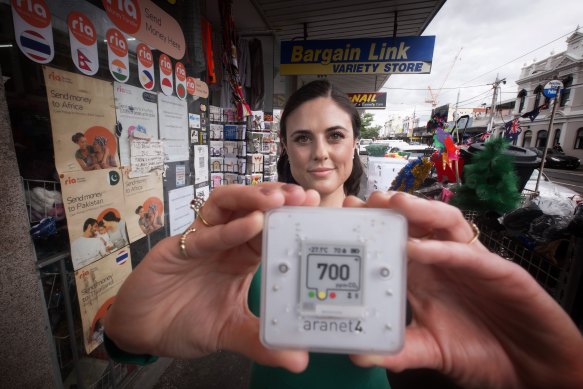Every time Emma Dalton sets foot in a shop, supermarket or cafe, she reaches into her handbag and pulls out her portable carbon dioxide monitor.
The $350 device allows her to quickly detect how much fresh air is circulating in her surrounds— information that helps protect her against COVID-19.

Emma Dalton measures the air quality of her local shopping strip in St Kilda EastCredit: Luis Enrique Ascui
If the C02 levels are too high — a sign that a space is not well ventilated — the device beeps and she swiftly leaves. She sometimes requests that a door or window be opened.
“If you are in a poorly ventilated environment, you are breathing in a lot of air that someone else has exhaled,” she explains. “It’s kind of disgusting.”
The St Kilda nurse, who delivers health and safety training, is among hundreds of Australians who have bought a monitor in an attempt to steer clear of the airborne virus.
They are also collecting useful data on air quality, with readings above 800 parts per million generally considered unsafe. Ms Dalton has recorded a reading over 1300 at her local supermarket and one exceeding 3000 in a car she was sharing with a colleague.
“It has certainly helped me identify areas that are riskier,” she said. “It also reassures me. When I go into a shop and the readings are really good, I think, ‘that is awesome, it’s a safer place’.”
While consumers stocked up on surgical masks and hand sanitiser during the earlier stages of the pandemic, they are now flocking to carbon dioxide monitors, N95 masks, air purifiers and oximeters.
Pharmacist Jenny Tan, at David Jones Pharmacy in Murrumbeena in Melbourne’s south-east, said oximeters had become a sought-after item for those wanting to monitor their COVID-19 symptoms at home.
“It’s one of the best ways they can track how things are going,” she said.
The small device, which clamps onto a person’s finger, uses infrared light refraction to measure oxygen saturation levels in the blood and heart rate. Readings below 95 per cent could be a sign that your situation is deteriorating and you need medical attention.
Ms Tan has sold out of N95 masks, with consumers keen to upgrade their surgical and cloth masks for better protection. A spokeswoman for Bunnings said the hardware chain had also experienced strong demand for its P2 respirators, which are essentially the same as N95 masks.
Denny Barichello, the director NuWave OxyPure Air Purifiers Australia, is selling up to 40 air purifiers a week and said sales had picked up in recent months. The $899 device claims to remove airborne pathogens and is being used in people’s living areas and bedrooms.
“It is a good time for air purifiers but not a good time for much else,” he said.
GP David Berger started importing carbon dioxide monitors last year after initially devising a scheme to loan out 20 of the devices to concerned individuals.
“I realised that there was a lot of demand, so I decided that the best way to get them out there and market them was to start importing them,” he said.
He said demand had skyrocketed by 1000 per cent since August and the Latvian factory that manufactured the popular Aranet devices was struggling to keep up with orders.
His clients include small businesses, people with underlying health conditions, massage therapists, dentists, GP clinics and private schools. He said some parents were sending their children to school with the devices to monitor the air quality of classrooms.
“We know COVID-19 is airborne, and we need a revolution in the way we look at indoor air quality,” he said.
He’d like to see the devices become more mainstream.
Dr Berger, who advocates for clean air and is behind the Twitter-based CO2 Guerrillas, said that in Japan the devices were being wired up to large screens outside shops and venues to display their carbon dioxide levels.
Kate Cole, president of the Australian Institute of Occupational Hygienists and a member of scientific lobby group OzSage, said measuring carbon dioxide was a useful “surrogate for COVID-19 infection risk”.
She also carries a carbon dioxide monitor with her and uses it to monitor the air quality of shops, cinemas and other public spaces.
“You want to spend your money in shops and businesses that improve air quality and have good clean air,” she said.
She said businesses could improve their ventilation by opening doors and windows, engaging a specialist to review their air quality or by installing air purifiers.
Australian Medical Association Victorian president Roderick McRae advocated for pulse oximeters to be distributed free of charge to those testing positive for COVID-19, so they could monitor their condition at home and avoid overwhelming the health system.
“It’s really part of the government’s management of a severe medical condition to help each citizen manage themselves at home,” he said.
Dr McRae said the device was a good way to identify early warning signs of serious disease and could be used by GPs monitoring patients at home to determine if they needed further medical attention.
However, he said air purifiers and carbon dioxide monitors were unnecessary for mainstream settings, where good ventilation was more effective.
“The key points are ventilation, open spaces, minimising the distance between people, and minimising big social events like cricket matches, tennis matches, New Year’s Eve parties, Australia Day barbecues, and all that sort of stuff.”
With Marta Pascual Juanola
Stay across the most crucial developments related to the pandemic with the Coronavirus Update. Sign up for the weekly newsletter.